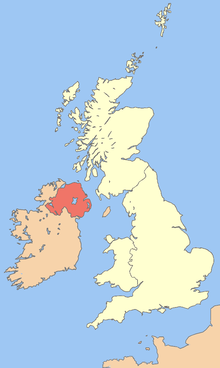Referendum in Northern Ireland 1973
On March 8, 1973, a referendum was held in Northern Ireland ( English Northern Ireland sovereignty referendum or English Border Poll ) on the question of whether Northern Ireland should remain part of the United Kingdom or join the Republic of Ireland . Voters voted by a large majority to remain in the United Kingdom, although the vote was largely boycotted by the Catholic population.
prehistory
Ireland was given extensive independence from the United Kingdom with the Government of Ireland Act of 1920. The northern part, in which the unionists had retained a majority in the general election, remained with the United Kingdom as Northern Ireland . In the first years after the partition, the domestic political climate in Northern Ireland was marked by violent clashes between the Irish Republican Army (IRA) and the police. Northern Ireland received self-government with a regional parliament in Belfast. However, Northern Irish politics and all government institutions, including the police, have been completely dominated by the Protestant majority. The Protestant control even over predominantly Catholic areas was secured by a corresponding constituency geometry. Catholics have faced discrimination on many occasions.
The conflict between pro-Irish Republican Catholics and pro-British Protestant Unionists broke out again with the Battle of the Bogside from August 12-14 , 1969 in Derry , when residents of the largely Catholic borough of Bogside settled down fought a street battle with the Royal Ulster Constabulary . The unrest spread from Derry to all of Northern Ireland, so that the British Army was sent to Northern Ireland by Home Secretary James Callaghan to restore order. The powers of the police were significantly expanded, so that, among other things, suspects could be interned without a court judgment . As a result, moderate Catholics also alienated themselves from state power. A climax of the violence was reached with the Bloody Sunday , the "blood Sunday" on January 30, 1972, when British paratroopers shot a total of 13 people in an unarmed demonstration. At the time, Northern Ireland was on the brink of civil war. From the point of view of the London government, the Northern Irish regional government seemed unable and unsuitable to restore orderly conditions. On March 30, 1972, the Parliament and Regional Government of Northern Ireland were suspended and Northern Ireland was placed under the direct control of the London government ( direct rule ). To create a clear picture, a referendum was called in which voters were asked if they wanted to remain part of the UK. The voters had two choices:
"Do you want Northern Ireland to remain part of the United Kingdom?"
"Do you want Northern Ireland to remain part of the UK?"
"Do you want Northern Ireland to be joined with the Republic of Ireland outside the United Kingdom?"
"Do you want Northern Ireland to be part of the Republic of Ireland outside of the UK?"
Referendum results
| proposals | be right | as a percentage of those who voted |
as a percentage of eligible voters |
|---|---|---|---|
| First proposal ("United Kingdom") | 591.820 | 98.9% | 57.5% |
| Second proposal ("Republic of Ireland") | 6,463 | 1.1% | 0.6% |
| Invalid votes | 5,973 | 1.0% | 0.6% |
An overwhelming majority of those who voted was in favor of remaining in the UK. The Ulster Unionist Party , the Alliance Party of Northern Ireland and the Labor Party of Northern Ireland had supported this vote, the Social Democratic and Labor Party had called for a boycott of the vote. This was justified with the endeavor not to fuel the violence. The BBC estimated that less than 1% of Catholics had voted. In absolute terms, there was not only a majority of those who voted, but also a majority of those eligible to vote.
As a result of this result, the parliament in London passed the Northern Ireland Constitution Act in 1973 , which reorganized the self-government of Northern Ireland. With the Sunningdale Agreement a division of political power between unionists and Irish nationalists was agreed. However, the IRA and radical unionists did not recognize the agreement and continued to rely on terrorist actions. Finally, a general Protestant strike in May 1974 led to the collapse of the agreement, so that Northern Ireland remained a source of political unrest until the Good Friday Agreement of 1998.
Individual evidence
- ↑ a b c The Referendums of 1973 and 1975. www.ark.ac.uk, accessed on January 22, 2014 (English).
- ↑ a b 1973: Northern Ireland votes for union. BBC, accessed January 22, 2014 .
